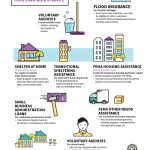PINE RIDGE, S.D. – For six months, FEMA has had a continued presence on the Pine Ridge Indian Reservation, supporting the Oglala Sioux Tribe in response and recovery efforts following a series of severe storms and flooding in May 2015. As part of that team, FEMA has hired about 20 tribal members to assist in operations. FEMA frequently hires within communities impacted by disasters for the local knowledge and expertise that such individuals can bring, and at Pine Ridge that has been no exception.
Ellen Martinez is a caseworker. In this role, she partners with a FEMA Individual Assistance program specialist and serves as a liaison to tribal members who have applied for disaster aid.
“One of the challenges is that people don’t want to let their damaged home go because of all the family history there,” Martinez said. “They are used to what they have. So we need to talk to them and explain that the new home will be healthier, safer and more secure, because people struggle with letting go of what they have.”
Martinez, like many of the local hires, started as an emergency liaison, going out with FEMA inspectors to view damage of homes. She is also in the unique position of being a disaster survivor in addition to working with FEMA. Her home was damaged in the storm and she received a new manufactured home. She shares her experience with the other applicants that she works with.
“FEMA is changing people’s lives”, Martinez said. “A lot of people didn’t know what FEMA is. They just registered but they didn’t understand the process. I can help explain that to them. I like helping people. I like the look on their face when they receive a new home. They are so grateful.”
Nancy S. Hussman came to FEMA after a lengthy career of service with tribal government. That background gave her a solid understanding of how the tribe works and how to get things done, helpful in her current position as a Voluntary Agency Liaison (VAL). As a VAL, she coordinates with agencies that seek to come on to the reservation and provide aid to tribal members in ways that FEMA can’t.
In addition to supporting the current disaster recovery effort, the experience gained by the tribal FEMA employees will end up serving the community in the future.
“It’s so great that FEMA has hired tribal members”, said Hussman. “When FEMA leaves there will be people who have been trained. We hope to keep a VAL department and we will be prepared to address a new disaster if we have one. And we will have one, whether it be tornado, fires or floods and we want to be better prepared. This is something that FEMA is teaching us.”
The tribal local hires have been able to help bridge the gap between federal government officials and the tribal community.
“We have been able to teach the FEMA people about our culture,” said Martinez. “How people look at things differently on the reservation. We’ve been able to show them how to approach tribal members as someone from off the reservation.”
“I think the FEMA staff have been receptive and they are learning about our culture,” said Hussman. “And that means a lot to our people. Because in general, many people are leery of the government. But FEMA has hired tribal members and because of that people have welcomed us into their homes and we have been able to do inspections and provide assistance.”
The newest members of the FEMA team have played an integral role, serving both the agency and their tribal community.




